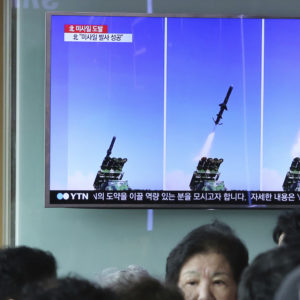The third iteration of a U.S.-North Korean rapprochement with a third generation dictator is missing one thing: nuclear brinkmanship.
While applying the maximum pressure of sanctions, President Trump has been willing to engage in one-on-one talks with Kim Jong-Un. On the other hand, Trump is far more confident of averting a nuclear doomsday scenario than any of his predecessors in office. American negotiators today, and in the future, can take comfort that the nation’s ballistic missile defense system will deter incoming nuclear missiles and with limited collateral damage.
Today, America fights an ideological cold war and minor hot wars with multiple enemies: communists, neo-czarists and jihadists. The emerging missile capabilities of Iran, the declared missile capabilities of North Korea and Pakistan, and the militaries of China and Russia are closing their technological gap with the United States.
Yet, rather than the sound of sirens alerting nuclear-attack drills, Americans are mesmerized by the twitter wars and the gutter humor of hapless comedians. It is the silent, unsung heroes of America’s ballistic missile defense operation that enable us to enjoy our freedoms and our carefree lives.
With a global array of networked ground, sea and space-based sensors for target detection and tracking, an extensive number of warhead interceptors, and battle management capabilities to link those sensors with those interceptors, America’s ballistic missile defense system (BMD) renders our enemies powerless and defangs their nuclear first-strike capability.
For many years, America and its allies have reliably counted on THAAD (Terminal High Altitude Area Defense). THAAD is a highly mobile, rapidly deployable system designed to shoot down attacking short- and medium-range missiles during their final or terminal phase of flight. Additionally, the Aegis system, deployed on U.S. Navy destroyers, can shoot down incoming short- and medium-range ballistic missiles. Our regional BMD system has strengthened alliances with treaty allies such as NATO, Australia, Japan, South Korea, and successfully defended Israel in a very rough neighborhood. The possibility of BMD participation has expanded the scope of bilateral cooperation with India.
In a May 2017 test, the GMD (Ground-based Mid-Course Defense) successfully destroyed an ICBM (Inter Continental Ballistic Missile) in space at the apogee of its flight path. Yes, Ronald Reagan’s promise to America long ago is a reality today! The development delays and the billions of dollars expended are understandable when one considers the complex architecture of sensors and communication-systems, which must all work in unison-timing and with a precision far greater than a Swiss watch.
An ICBM launched from the Kamchatka Peninsula in far eastern Russia, close to the Chinese-North Korean border, can hit Alaska in under 6 minutes and California in under 12 minutes. The GMD, a system of ground-based interceptors, at Fort Greely (Alaska) and at Vandenberg Air Force Base (California), can shoot an Exo-atmospheric Kill Vehicle beyond the troposphere to precisely collide with the ICBM. The EKV is not armed with an explosive; the impact of the collision itself destroys the warhead.
ICBMs launched anywhere from earth can now be diverted and destroyed in outer space without the damage from scattering nuclear debris. Thus, obviated are the hazards of destroying a mid-course ICBM with explosives dropped from an F-16 airplane.
Every year, on Memorial Day, we are reminded to never take liberty for granted. Freedom is not free, we are told. However, we are comforted by the knowledge that our nation cannot be blackmailed by missile-toting rogue regimes. Indeed, the GMD system in operation is a great day for America and a very bad day for Kim Jong-Un.

